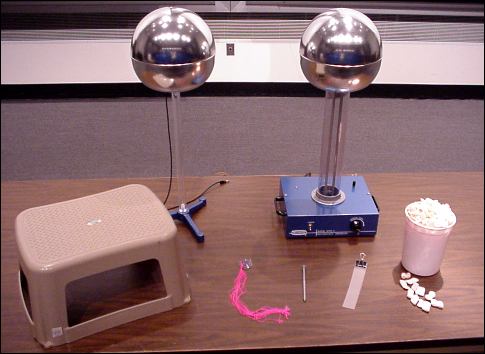
Background:
Although atoms contain both negatively and positively charged particles, they do so in equal amounts and carry no net charge. This balance can be temporarily disrupted by rubbing one material against another. One device, known as a Van de Graaff generator, uses a fast moving rubber belt to charge a metallic dome to nearly 200,000 Volts. This activity uses a Van de Graaff generator to study the behavior of electrical charges.
Objectives:
In this activity students will:
- make predictions of the outcomes of several experiments
- observe experiments
- record their outcomes
Minimum Materials Needed:
- Van de Graaff generator
- Grounding dome
- Insulated platform, such as a rubber stool
- Suction cup with strings attached to it
- Container full of packing foam
- Long nail
Optional Materials:
- Electroscope

Materials for Electrostatics
Notes:
- Nearby computer equipment should be turned off prior to using a Van de Graaff generator.
- High humidity will prevent these experiments from working.
- A simple electroscope can be constructed from two strips of overhead transparency.
- The electroscope will need to be cleaned from time to time as it will collect oils from your fingers.
Detailed Directions:
1. Rub your fingers between the electroscope's leaves.
results: The leaves open since they both carry the same electrical charge (usually negative).
2. Place an insulator, such as a plastic pen, between the leaves of the electroscope.
results: There is little or no effect. The electrons in the insulator are repelled by the extra electrons on the electroscope's leaves, but they cannot easily move away through the insulator.
3. Place a conductor, such as a metal nail, between the leaves of the electroscope.
results: The electroscope's leaves jump to the conductor. The electrons in the conductor are repelled by the extra electrons on the electroscope's leaves. The electrons in the conductor easily flow away, leaving their parent atoms behind. The parent atoms, now missing a few electrons, now posses a net positive charge that attracts the negative charge on the leaves.
4. Turn the Van de Graaff generator on and place the grounding dome near it.
results: A large spark will jump from the dome of the Van de Graaff generator to the grounding dome. As the grounding dome is brought closer to the Van de Graaff generator, the sparks become smaller but occur at a faster rate.
5. Place a container full of packing foam on the Van de Graaff generator and turn it on.
results: The packing foam flies out of the container and away from the Van de Graaff generator. As the Van de Graaff generator charges, electrons collect on its dome, the container and the packing foam. Since the packing foam becomes negatively charged, it is repelled by the other pieces of foam and the Van de Graaff generator itself.
6. Place the suction cup with strings attached on the Van de Graaff generator and turn it on.
results: All of the strings stand on end. As the Van de Graaff generator charges, electrons collect on its dome and the strings. Since the strings becomes negatively charged, they are repelled by each other as well as the Van de Graaff generator.
7. Stand on an insulated stool, place one hand on the Van de Graaff generator and turn it on.
results: Your hair, if it able to, will stand on end for the same reason the strings did.
8. While still charged, place your other hand on the Van de Graaff generator.
results: There is no effect. Both of your hands are at the same potential so no current flows through your body. This is also why birds can land on electrical wires without receiving a shock.
9. While still charged, hold the nail in one hand while slowly bringing it toward the grounding dome.
results: As you bring the nail toward the grounding ball, your hair will start to return to normal. Charges tend to leak off of objects with points, such as the nail. As the electrons flow toward the grounding dome, you lose charge and your hair falls. A spark will jump from the nail to the grounding dome once they get to within a quarter inch or so. Although there is a high potential difference between your two hands (on the order of 200,000 Volts), the electricity flowing through your body does not harm you because the current (the amount of electricity that is flowing through your body) is low.
10. Once you have fully recharged yourself, remove your hands from the Van de Graaff generator but do not step off of the insulated stool.
results: Since you are insulated from the ground, your hair remains standing. It will slowly fall as the charges leak away from you.
11. While you still have some residual charge, step off of the insulated stool.
results: Your hair falls flat as soon as your foot touches the ground. Although you are (hopefully!) wearing shoes, they usually don't provide enough insulation to prevent most of the excess electrons on your body from sparking through them to the ground.
Citation and linking information
For questions about this page, please contact Steve Gagnon.
